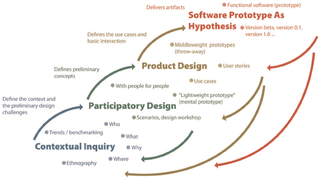Related Research Articles

Usability can be described as the capacity of a system to provide a condition for its users to perform the tasks safely, effectively, and efficiently while enjoying the experience. In software engineering, usability is the degree to which a software can be used by specified consumers to achieve quantified objectives with effectiveness, efficiency, and satisfaction in a quantified context of use.
User-centered design (UCD) or user-driven development (UDD) is a framework of process in which usability goals, user characteristics, environment, tasks and workflow of a product, service or process are given extensive attention at each stage of the design process. These tests are conducted with/without actual users during each stage of the process from requirements, pre-production models and post production, completing a circle of proof back to and ensuring that "development proceeds with the user as the center of focus." Such testing is necessary as it is often very difficult for the designers of a product to understand intuitively the first-time users of their design experiences, and what each user's learning curve may look like. User-centered design is based on the understanding of a user, their demands, priorities and experiences and when used, is known to lead to an increased product usefulness and usability as it delivers satisfaction to the user.
Contextual may refer to:
The following outline is provided as an overview of and topical guide to human–computer interaction:
Participatory design is an approach to design attempting to actively involve all stakeholders in the design process to help ensure the result meets their needs and is usable. Participatory design is an approach which is focused on processes and procedures of design and is not a design style. The term is used in a variety of fields e.g. software design, urban design, architecture, landscape architecture, product design, sustainability, graphic design, planning, and health services development as a way of creating environments that are more responsive and appropriate to their inhabitants' and users' cultural, emotional, spiritual and practical needs. It is also one approach to placemaking.

User interface (UI) design or user interface engineering is the design of user interfaces for machines and software, such as computers, home appliances, mobile devices, and other electronic devices, with the focus on maximizing usability and the user experience. In computer or software design, user interface (UI) design primarily focuses on information architecture. It is the process of building interfaces that clearly communicate to the user what's important. UI design refers to graphical user interfaces and other forms of interface design. The goal of user interface design is to make the user's interaction as simple and efficient as possible, in terms of accomplishing user goals.
In the field of human–computer interaction, a Wizard of Oz experiment is a research experiment in which subjects interact with a computer system that subjects believe to be autonomous, but which is actually being operated or partially operated by an unseen human being.

A persona in user-centered design and marketing is a personalized fictional character created to represent a user type that might use a site, brand, or product in a similar way. Personas represent the similarities of consumer groups or segments. They are based on demographic and behavioural personal information collected from users, qualitative interviews, and participant observation. Personas are one of the outcomes of market segmentation, where marketers use the results of statistical analysis and qualitative observations to draw profiles, giving them names and personalities to paint a picture of a person that could exist in real life. The term persona is used widely in online and technology applications as well as in advertising, where other terms such as pen portraits may also be used.
Empathic design is a user-centered design approach that pays attention to the user's feelings toward a product. The empathic design process is sometimes mistakenly referred to as empathetic design.
Contextual design (CD) is a user-centered design process developed by Hugh Beyer and Karen Holtzblatt. It incorporates ethnographic methods for gathering data relevant to the product via field studies, rationalizing workflows, and designing human–computer interfaces. In practice, this means that researchers aggregate data from customers in the field where people are living and applying these findings into a final product. Contextual design can be seen as an alternative to engineering and feature driven models of creating new systems.

An interaction technique, user interface technique or input technique is a combination of hardware and software elements that provides a way for computer users to accomplish a single task. For example, one can go back to the previously visited page on a Web browser by either clicking a button, pressing a key, performing a mouse gesture or uttering a speech command. It is a widely used term in human-computer interaction. In particular, the term "new interaction technique" is frequently used to introduce a novel user interface design idea.
An experience model is a description of the key attributes that drive end-user experience when interacting with a system, product, or service. These attributes may be a combination of end-user attributes and those of the system or environment. These attributes are typically uncovered as insights exposed through behavioral research. Experience models are typically visually represented by abstract diagrams or visualizations to enhance understanding of the attributes and how they influence experience and engagement. The value of an experience model is to help designers focus on solution options that are most likely to improve end-user experience outcomes.

Human–computer interaction (HCI) is research in the design and the use of computer technology, which focuses on the interfaces between people (users) and computers. HCI researchers observe the ways humans interact with computers and design technologies that allow humans to interact with computers in novel ways. A device that allows interaction between human being and a computer is known as a "Human-computer Interface (HCI)".
User experience evaluation (UXE) or user experience assessment (UXA) refers to a collection of methods, skills and tools utilized to uncover how a person perceives a system before, during and after interacting with it. It is non-trivial to assess user experience since user experience is subjective, context-dependent and dynamic over time. For a UXA study to be successful, the researcher has to select the right dimensions, constructs, and methods and target the research for the specific area of interest such as game, transportation, mobile, etc.
Living labs are open innovation ecosystems in real-life environments using iterative feedback processes throughout a lifecycle approach of an innovation to create sustainable impact. They focus on co-creation, rapid prototyping & testing and scaling-up innovations & businesses, providing joint-value to the involved stakeholders. In this context, living labs operate as intermediaries/orchestrators among citizens, research organisations, companies and government agencies/levels.
Agile usability engineering is a method created from a combination of agile software development and usability engineering practices. Agile usability engineering attempts to apply the principles of rapid and iterative development to the field of user interface design.

Joan Greenbaum is an American political economist, labor activist, and Professor Emerita at the CUNY Graduate Center and LaGuardia Community College. She also taught and conducted research at Aarhus University, and the University of Oslo (Informatics) (1995–96). Her numerous books and articles focus on participatory design of technology information systems, technology and workplace organization, and gender and technology.

The research-based design process is a research process proposed by Teemu Leinonen, inspired by several design theories. It is strongly oriented towards the building of prototypes and it emphasizes creative solutions, exploration of various ideas and design concepts, continuous testing and redesign of the design solutions.
Contextual application design in digital media is the adaptation of the contextual design process developed by Hugh Beyer and Karen Holtzblatt, in the mobile software space, taking advantage of the measurability of the media, context awareness technologies in mobile devices, aggregation and analytics systems, to create a user-centered design process where developers aggregate data from users' real-world behavior and patterns, and applying these findings into a final product.
Karen Holtzblatt is an American computer scientist known for her contributions in human–computer interaction, and particularly in contextual design. She founded InContext Design in 1992 and is its CEO. Holtzblatt was elected to the CHI Academy in 2007 and won the inaugural ACM SIGCHI Lifetime Award for Practice in 2010. Holzblatt is also affiliated with the University of Maryland, as a research scientist in the Human-Computer Interaction Lab and iSchool.
References
- ↑ J. Whiteside, J. Bennett, and K. Holtzblatt, "Usability Engineering: Our Experience and Evolution," Handbook of Human Computer Interaction, M. Helander (Ed.). New York: North Holland, 1988.
- ↑ D. Wixon, K. Holtzblatt, and S. Knox, "Contextual Design: An Emergent View of System Design," in Proceedings of CHI '90: Conference of Human Factors in Computing Systems, 1990. Seattle, WA.
- 1 2 Beyer, H. and Holtzblatt, K. "Apprenticing with the Customer," Communications of the ACM, May 1995.
- ↑ Beyer, H. and Holtzblatt, K., Contextual Design: Defining Customer-Centered Systems, Morgan Kaufmann Publishers Inc., San Francisco (1997).
- ↑ K. Holtzblatt and H. Beyer, "Making Customer-Centered Design Work for Teams," Communications of the ACM, October 1993.
- ↑ K. Holtzblatt and H. Beyer, "Representing work for the Purpose of Design," in Representations of Work, HICSS Monograph (Hawaii International Conference on System Sciences), January 1994. Lucy Suchman, Editor.